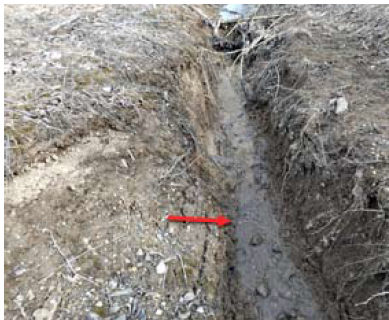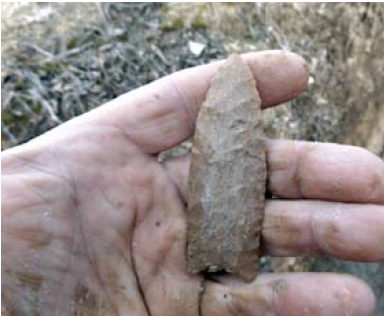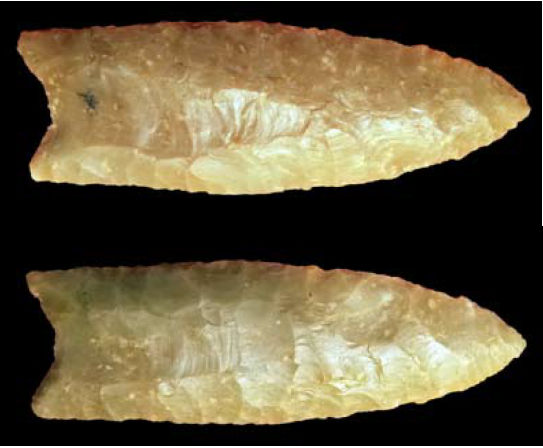|
Read this and more in the Central
States Archaeological Societies 2019
January Journal which can be purchased on-line after March 2020
|
|
|
At top: Figure 1. The ditch where the Clovis was
found looking west. Note the depth of the ditch.
|
January 1st 2017, was like most any other New Year’s Day. But it was
a relatively warm winter day, so my wife and I decided to hit the fields. We
were not having much luck, so I decided to call it quits, hoping that the rain
and snow forecasted for later in the week would knock down the dirt.
As we drove through town we noticed that an auction was going on at the
Hancock County Fairgrounds and decided to check it out. Towards the end of
the auction we were threading our way through the crowd heading out, when
a man walked up to me and asked if I would like to check out a Clovis he
had found recently. Most likely, my relic T-shirt was noticed by him as I was walking around looking at things.
Together we walked out to his car and introduced ourselves. He was James
Laswell. He asked if I had heard of him, to which I replied that I had not.
He began telling me a story that had been published in the Central
States Archaeological Journal in October 2015 issue regarding a pipe he had
found.
CLICK
TO VIEW LARGE IMAGE
|
 |
James holding the Laswell great pipe found July 16th, 2012 |
As he was telling me the story of the pipe, he reached into his car and
picked up a frame holding the Clovis. He then told me that after finding
the pipe
he had become interested in hunting for Indian artifacts. He stated that
on February 19 2016, outside of Pendleton Indiana, while hunting a field
with his brother (a field I also have hunted with Darrell Cross), he came
upon a drainage ditch that had an enormous amount of water flowing through
it after four continuous days of heavy rain. The water in the ditch had
eroded the sides, exposing the Clovis for the first time. The depth the Clovis
was
found was well below the plow zone. It was still in
pristine condition.
CLICK TO VIEW LARGE IMAGE |
 |
| Figure 2. The the arrow points to the Clovis, the small
white area in the water. |
| |
CLICK TO VIEW LARGE IMAGE |
 |
| 3. The Clovis in hand immediately after being found. |
| |
| Read this and more in the Central States Archaeological Societies 2019
January Journal which can be purchased on-line after March 2020 |
Luckily, he had the presence of mind to photograph the site and Clovis immediately
after finding it (Figs. 1-3).
A few days later I met with him (January 11th 2017) and acquired the Clovis
(Fig. 4). Since then, James and I have searched for relics together and over
the course of time have come to be good friends Clovis points are the characteristically-fluted
projectile points associated with the North American Clovis culture. They
date to the Paleoindian period around 13,500 years ago. Clovis fluted points
are named after the city of Clovis, New Mexico, where examples were first
found in 1929.
A typical Clovis point is a medium to large lanceolate point. Sides are
parallel to convex, and exhibit careful pressure flaking along the blade
edge. The broadest area is near the midsection or toward the base.
The base is distinctly concave with a characteristic flute or channel flake
removed from one or, more commonly, both surfaces of the blade. The lower
edges of the blade and base are ground to dull edges for hafting. Clovis
points also tend to be thicker than the typically thin later-stage Folsom
points, with length ranging from 4–20 centimeters (1.6–7.9 in)
and width from 2.5–5 centimeters (0.98–1.97 in).
Clovis points were first discovered near the city of Clovis, New Mexico,
and have since been found over most of North America 2 and as far south as
Venezuela. Significant Clovis finds include the Anzick site in Montana; the
Blackwater Draw type site in New Mexico;the Colby site in Wyoming; the Gault
site in Texas; the Simon site in Idaho; the East Wenatchee Clovis Site in
Washington; and the Fenn cache, which came to light in private hands in 1989
and whose place of discovery is unknown. Clovis points have been found northwest
of Dallas, Texas.3
In May 2008 a major Clovis cache, now called the Mahaffey Cache, was found
in Boulder, Colorado, with 83 Clovis stone tools. The tools were found to
have traces of horse and cameloid protein. They were dated to 13,000 to 13,500
YBP, a date confirmed by sediment layers in which the tools were found and
the types of protein residues found on the artifacts.4
 |
|
|
| Figure 4. Both faces of the Clovis. It measuresexactly
3 inches in length, 1 1/32 at its widest. The flute is 1 5/8 inches in
length |
| |
CLICK
TO VIEW LARGE IMAGE |
|
James Laswell of Anderson Indiana, holding the clovis found February
19 2016 in Pendleton Indiana.
|
2 Justice, Noel D. (1995), Stone Age Spear and Arrow Points
of the Midcontinental and Eastern United States: a modern survey and reference
(reprint ed.), Indiana University Press, p. 17, ISBN 978-0-253-20985-6
3 Elias, Scott A. “Paleoindian and Archaic Peoples”. People of
the Colorado Plateau. Northern Arizona University.
4 “13,000-Year-Old Stone Tool Cache in Colorado Shows Evidence of Camel,
Horse Butchering.” University of Colorado at Boulder.
February 25, 2009. Retrieved 22 September 2010.




